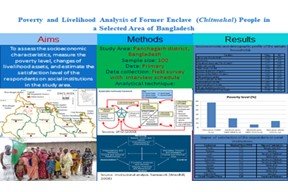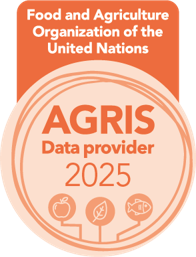Poverty and livelihood analysis of Former Enclave (Chitmahal) people in a selected area of Bangladesh
Abstract
With the aim of creating development programs for the residents of the former enclave (Chitmahal), a survey of their poverty and livelihoods is essential. In this study, socioeconomic factors, poverty levels, changes in livelihood assets, and respondent satisfaction levels with social institutions in the study area were all assessed. A total of 100 respondents were randomly selected from Debiganj Upazila in the Panchagarh district of Bangladesh. A survey approach was employed to obtain the data. Respondents were able to respond quickly to questions and indicate their level of agreement with five points using a five-point Likert scale. The data were analyzed using the Direct Caloric Intake (DCI) approach and DFID's Sustainable Livelihoods Framework. The main finding of the study was that the average age of the head of family was within the working age range. The average size of a household was medium. The head of family has only completed nearly five years of school. Three-fifths of those surveyed had high household incomes. The majority of households had poverty. After becoming a citizen of Bangladesh, the five asset classes- human assets, social assets, natural assets, physical assets and financial assets were positively changed. Satisfaction with social institutions has been moderate. In order to reduce poverty and improve the standard of living of households in the research area, social institutions need to be more efficient.
Keywords:
Bangladesh, Enclave, Livelihood, Poverty, Social institutionsDownloads
References
BBS (2020). Bangladesh Bureau of Statistics, Statistical Year Book of Bangladesh, Ministry of Planning, Government of the People’s Republic of Bangladesh, Dhaka.
BER (2020). Bangladesh Economic Review. Ministry of Finance, Government of the People’s Republic of Bangladesh, Dhaka.
Bhattacharya, D. (2018). Study on Impact of Execution of LBA, 2015 on the Erstwhile Enclaves’ People of India and Bangladesh. PEOPLE: International Journal of Social Sciences, 4(2),1166-1187.
Chowdhdury, M. L. H. (2018). Socio-Economic Conditions of the Enclave People in Bangladesh: Problems and Prospects. A Dissertation submitted to the University of Dhaka for the Degree of Master of Philosophy (M. Phil) in Political Science. University of Dhaka.
Cons, J. (2012). Histories of Belonging(s): Narrating Territory, Possession, and Dispossession at the India-Bangladesh Border. Modern Asian Studies, 46, pp. 527-558.
DFID (2000). Sustainable Livelihoods Guidance Sheets. Department for International Development. http://www.Livelihoods.Org/Info/Info_Guidanceshessts.Html (Accessed on June 12, 2020).
HIES (2016). Household income and expenditure survey. Bangladesh Bureau of Statistics, Ministry of Planning, Government of the Peoples’ Republic of Bangladesh.
Jugantor (2015). Report of Jugantor. Dhaka: Bangladeshi Newspaper.
Lara, H. R. (2017). Role Performance of Social Institutions in. Student Activities. Asia Pacific Journal of Multidisciplinary Research, 5(1),173-180
Misu, F., Khatun, M. A., & Islam, M. A. (2020). Are the Enclaves on the Same Boat? An Investigation on the Development Indicators of Dahagram-Angarpota of Bangladesh Article. South Asian Survey, 28(1), 1-23, https://doi.org/10.1177/0971523120947318
Quizlet (2022). 10 primary social institutions, Available at: https://quizlet.com/29185329/10-primary-social-institutions-flash-cards/ Accessed on July 26, 2022.
Rabbani, M. G. (2005). Statelessness in South Asia: Living in Bangladesh-India Enclaves.
Rabbni, M. G. (2007). Statelessness in South Asia: Living in Bangladesh-India Enclaves. Theoretical Perspectives, 12 , 13, 1–60.
Rabbani, M.R., Qadri, F. A., and Ishfaq, M. (2016). Service Quality, Customer Satisfaction and Customer Loyalty: An Empirical Study on Banks in India. VFAST Transactions on Education and Social Sciences, Volume 11, Number 2,pp.1-9.
Rose, A. M. (1957). Sociology: The study of Human Relations Knopf Wiley, New York.
Saha, S. (2013). “The Socio-economic conditions of Indo-Bangla Enclaves”, The International Journal of Scientific & Engineering Research,4 (7), Retrieved from https://www.ijser.org/researchpaper/The-Socio-economic-conditions-of-Indo-Bangla-Enclavespeople.pdf.
Schendel, W. V. (2002). The Bengal Borderland. London: Anthem Press.
Schendel, W. V. (2002). Stateless in South Asia: The Making of the India-Bangladesh Enclaves, The Journal of Asian Studies, 61(1), 115-147, Retrieved from https://doi.org/10.2307/2700191
Scoones, I. (1998). Sustainable rural livelihoods: A framework for analysis. IDS Working Paper 72. Brighton: Institute of Development Studies.
Woodhill, J. (2008). Shaping Behaviour: How Institutions Evolve. The Broker. Available at: www.thebrokeronline.eu/en/Articles/Shaping-behaviour (accessed 12 June 2020.)
World Bank (2000). World development report 2000/2001. Attacking poverty. Washington, DC: World Bank.
Yunus, A. S. M. (2015). Enclaves: Introducing Stateless Folk in South Asia, Mohammad Abdul Hannan (Translated), Dhaka: Annesha Prokashon, April, pp. 30-160.
Zakaria, A. K. M., Mamun, M. A., Majid, M. A., & Sultana, R. (2020). Livelihood Status of the People Living in Unified Enclaves (Chitmahal) of Bangladesh. Asian Journal of Education and Social Studies, 8(2), 37–45, https://doi.org/10.9734/ajess/2020/v8i230220

Published
How to Cite
Issue
Section
Copyright (c) 2023 Agriculture and Environmental Science Academy

This work is licensed under a Creative Commons Attribution-NonCommercial 4.0 International License.

